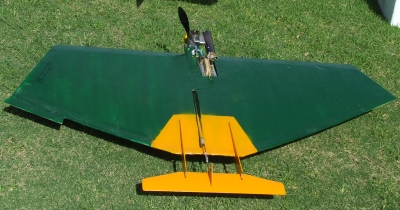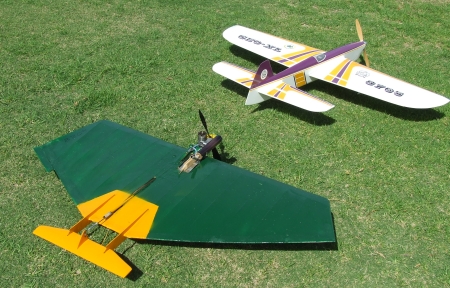|
A decade or so back, my daughter Remy and I passed thru
Bakersfield, where we took the chance to see the Republic
F84H Thunderscreech. This exotic aircraft was a gate guardian
at Bakersfield Municipal Airport. I gather it is not there anymore,
having been moved to the Airforce Museum in Dayton, Ohio.
From there we headed to Van Nuys airport, in the North-Western
approaches to Los Angeles, where some of the heavy metal
Reno race planes were hangared. Imagine my surprise, then, to find
a rubber-powered man-carrying ultra-light in one of the hangars!
Now this could all be irrelevant to our modelling needs if it weren't
for just one thing. This aircraft, the Rubber Bandit, had an electronic
flight control system. Well, not really. The stab and rudder were
moved by ordinary R/C servos, with the pilot using a regular R/C
transmitter to operate them! Not so remarkable, perhaps, if it were
not for the fact that the fully-flying rudder was at least 8 feet high
and 2 feet wide!
So I bought a T-shirt and asked George Heaven, the designer, how he
expected the servo to move such a huge control surface. It seems
there is a trick to this: but first, did it work? Well George had mounted
this rudder on the back of a pick-up truck, and used it to steer the
vehicle down the Van Nuys Runway! All by a crummy little R/C servo.
Here is the trick. The rudder (no fin) was hinged at the 25% chord
position. The rudder was a rectangle, so figuring out the 25%
location was a no-brainer. Also, the airfoil section was symmetrical.
Now it turns out that if you do this, there is no effort required of the
pilot (or servo) to turn this surface against air loads, yet the
rudder is fully effective at steering the airplane! Truly amazing!
I had to try this for myself. I restored the Bat flying wing and fitted
Voodoo type elevators, which you can see in the photo. But I also
hinged them at 20% of mean chord. I don't know how much all
this moved the C/G back, but I can tell you the elevator was extremely
effective, to the point of the model being hard to fly. I halved the
elevator throw and was then pleased with the handling. There is
still a need to move the C/G forward a little.


There was another unexpected result. Previously, the model would
glide like a brick: there was no way it would glide for the lap required
by the F2B rules. In fact, it was down in1/3 of a lap from full speed!
I thought this was the draggy muffler and engine hanging out in the
breeze. But with the new elevator, 2/3 lap glide was no problem at all.
It seems that the Dominator style slab elevator hanging onto the trailing
edge was very draggy, both losing lift and adding drag.
So this is something to take on board and think about before you build
your next yo-yo. Certainly it is a fun thing to try!
|